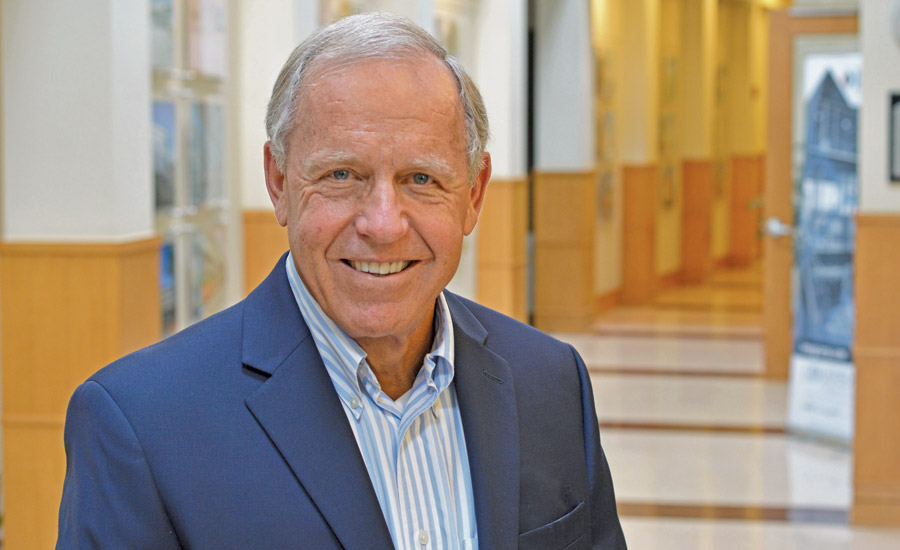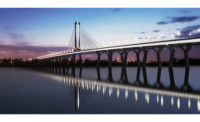As CEO and president of IMEG Corp., Paul VanDuyne has built the engineering consulting firm from the ground up into a powerhouse, making it one of the sector’s fastest growing firms in the Midwest.
The winner of ENR’s Legacy Award, VanDuyne’s accomplishments are even more impressive given how close he came to pursuing a very different passion: chiropractic medicine
As a young engineer with a degree in electrical engineering from Drexel University and who did additional study in the MBA program at Rutgers, VanDuyne left a job at a family-owned engineering firm in New Jersey that had gone sour after the founder’s son, a CPA, took the reins and began treating employees as “widgets,” VanDuyne recalls.
In the late 1970s, VanDuyne moved halfway across the country and took a part-time job doing drafting work for $5 an hour at KJWW, IMEG’s predecessor company, while studying to be a chiropractor.
VanDuyne told everyone at the then-small engineering consulting firm based in Rock Island, Ill., that he was simply supporting himself until he earned his degree and could begin to practice as a chiropractor.
“I was a little bit of an oddball and was going to a chiropractic college and was going to get out of engineering,” he says. “It’s been an interesting journey.”
VanDuyne, who received a doctorate at the Palmer College of Chiropractic in Davenport, Iowa, in 1978 found himself drawn back into the world of engineering by the opportunity to build an engineering/design practice in health care. He put aside plans to become a practicing chiropractor to go to work full-time for KJWW, joining as employee No. 16.
He rose through the ranks to become head of what is now IMEG in 2003, with the employee-owned firm catapulting from a few hundred employees to nearly 2,100 today.
IMEG is now ranked No. 71 among ENR’s Top 500 Design Firms, its rise powered by organic growth and a flurry of acquisitions.
Kent Pilcher, president and CEO of Estes Construction, part of the EPHC team of companies, says his firm has worked alongside VanDuyne and IMEG on projects for years.
“He is highly professional but still down to earth,” Pilcher says. “He is one of the first people to the table with creative ideas or to solve a problem. He exhibits a great sense of humor and a great sense of integrity. It is easy to build a rapport with someone like that.”

Advocate Sherman Hospital in Elgin, Ill., was one of the first two hospitals in the U.S. to use a lake-coupled geothermal system.
Photo courtesy of IMEG Corp.
KJWW Spotted VanDuyne’s Potential
Merging his growing interest in health care with his engineering expertise, VanDuyne built KJWW’s health care design practice from scratch, cold calling community hospitals to see if they had any plans for new additions or other work.
Three small projects for hospital clients in the early days—McDonough District Hospital in Macomb, Ill.; Cottage Hospital in Galesburg, Ill., and Perry Memorial Hospital in Princeton, Ill.—opened the door for the firm to get into the health care market.
These projects led to the firm’s first major health care job with Advocate Condell Medical Center in Libertyville, Ill., which was completed in 2005. The $65 million expansion and renovation was the result of a master plan designed to turn the 70-year-old hospital into a regional medical center.
Meanwhile, VanDuyne moved up the corporate ladder, going from senior design engineer and vice president/client executive to president.
By 2011, half of the firm’s projects were in health care, which remains as large as ever, even as health care’s proportion of the firm's overall portfolio has shrunk as other business has grown.
Early Pioneer in Energy Efficiency
Under VanDuyne’s watch, KJWW began to push into pioneering geothermal projects.
The firm designed the first and largest lake-coupled geothermal hospital in the country, Great River Health Medical Center in West Burlington, Iowa, which enabled the hospital to reduce its energy usage by 63% compared with the average health care institution.
“One of the things we have always prided ourselves on is being really technically competent,” VanDuyne says. The Iowa hospital “really wanted to be energy efficient in a big way.”
Under VanDuyne’s tenure, the firm also designed the first LEED Platinum data center in the U.S. for ACT Inc. in Iowa City, which was completed in 2008.
The company also designed the-then largest LEED Platinum office building in 2010 and, more recently, the net-zero energy LEED Platinum Denver Water administration building, which also incorporates the ‘One Water’ design concept for maximum water efficiency. The project won the ACEC National Grand Conceptor Award in 2021.
“One of the things we have always prided ourselves on is being really technically competent.”
—Paul VanDuyne, CEO & President, IMEG Corp.
By 2014, VanDuyne had reached another crossroads and was weighing whether to hang up his hat and retire. After some soul searching, VanDuyne decided there were still challenges ahead and started growing the firm through acquisitions. He led a merger in 2015 between KJWW and a California firm that resulted in the creation of IMEG.
It is just one of dozens of different acquisitions and mergers VanDuyne has overseen in the past few years.
It’s not the number of deals that VanDuyne takes the most pride in, but what he contends is a stellar track record of success integrating new firms.
VanDuyne’s approach to mergers is the opposite of the stereotypical corporate acquisition, with one company devouring another while laying off large numbers of employees.
He personally writes every letter of acquisition, laying out the details in laymen’s terms.
IMEG doesn’t bring in new leadership when companies had been doing well already and were attractive additions. Rather, IMEG considers an acquisition to be successful when it is able to keep the firm’s leadership in place, among other criteria.
“These are good companies; we want them to operate like they did and slowly integrate into IMEG,” VanDuyne says.
Patrick Eikenberry, executive vice president of civil engineering, who joined IMEG in 2018 as part of a merger, considers VanDuyne a mentor.
“I was drawn to his energy and his knowledge of how to grow a business,” Eikenberry recalls.
Eikenberry’s firm brought civil engineering expertise that IMEG had lacked, and in turn, has spurred a major acceleration in growth since the merger.
“We don’t look for deals,” Eikenberry says. “Brokers bring Paul deals; they believe in his methods.”

Paul and Donna VanDuyne at the hall named in their honor at Palmer College of Chiropractic.
Photo courtesy of Palmer College of Chiropractic
Dedication to Giving Back
Over the years, VanDuyne has also stood out for his dedication to giving back, both to the Quad Cities where he and his wife, Donna, live and to the communities where IMEG does business—and to the engineering industry as well.
VanDuyne has chaired the boards of the Quad Cities Chamber of Commerce, the Bettendorf Family Museum, The Learning Center, Ballet Quad Cities and Rivermont Collegiate.
“He is a very selfless person,” says Pilcher, the fellow CEO, who has served with VanDuyne on a number of nonprofit boards. “Both he and his wife have been very committed in our community. If you look at someone who is the epitome of success, he and his wife would be the poster children.”
VanDuyne also stayed involved with his alma mater, Palmer College of Chiropractic, and now serves as vice president of the board of trustees. He and his wife are co-chairing the college’s current fundraising campaign and have led the way with a significant donation, with Palmer naming a new housing complex after them.
VanDuyne’s wife teases him about his infectious enthusiasm for volunteering with local nonprofits.
“My wife jokes when I join a new organization—she says, ‘When are you going to be president?’ Sure enough, two years later, there I am, president.”
VanDuyne has been very active in industry organizations as well, including the Design Futures Council, NSPE, IES and AEE. He also contributes his time and talents to Chief Executive Network and Strategic Coach, which coaches up-and-coming entrepreneurs and offers peer-to-peer mentoring.
If that weren’t enough, VanDuyne has also done some deep thinking about some of the social issues related to bias and equity that all industries are grappling with.
He recently co-authored “Equity by Design: Overcoming Bias and Capitalizing on Data to Reach Broader Outcomes,” which was published by Design Intelligence.
VanDuyne’s essay looks at how AEC firms can overcome bias and explores how design has evolved over the years, from just making buildings that “work” to considering the ways in which the built environment can impact social equality.
“Don’t be blind to the community you are building in,” VanDuyne advises. “How can you build [a project] so that it’s a little more inclusive and stimulates people to think in a different way and overcome biases. People have biases. It’s when you have those unintended biases that you hurt people. As design professionals, we have a responsibility to consider that.”
Looking ahead, VanDuyne sees more growth and more acquisitions in IMEG’s future.
He’s pushing to double IMEG’s footprint, which currently stands at 75 offices across the country.
“We call ourselves a national firm with a local presence,” VanDuyne says. “If we are looking ahead five years from now, I hope we have 150 offices from coast to coast.”






Post a comment to this article
Report Abusive Comment